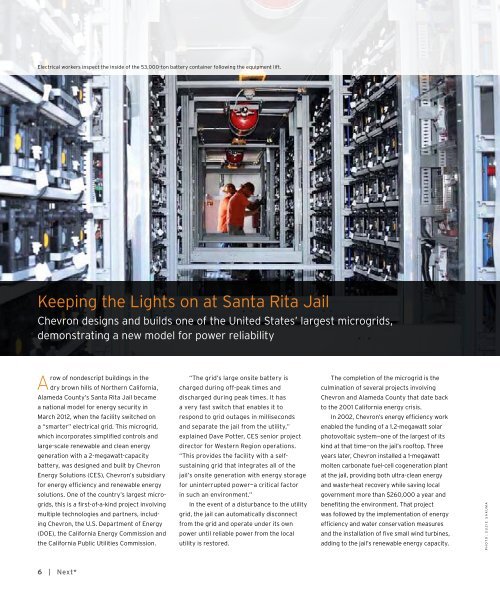Next* Magazine, Issue 5 - Chevron
Next* Magazine, Issue 5 - Chevron
Next* Magazine, Issue 5 - Chevron
You also want an ePaper? Increase the reach of your titles
YUMPU automatically turns print PDFs into web optimized ePapers that Google loves.
Electrical workers inspect the inside of the 53,000-ton battery container following the equipment lift.<br />
Keeping the Lights on at Santa Rita Jail<br />
<strong>Chevron</strong> designs and builds one of the United States’ largest microgrids,<br />
demonstrating a new model for power reliability<br />
row of nondescript buildings in the<br />
A dry brown hills of Northern California,<br />
Alameda County’s Santa Rita Jail became<br />
a national model for energy security in<br />
March 2012, when the facility switched on<br />
a “smarter” electrical grid. This microgrid,<br />
which incorporates simplified controls and<br />
large-scale renewable and clean energy<br />
generation with a 2-megawatt-capacity<br />
battery, was designed and built by <strong>Chevron</strong><br />
Energy Solutions (CES), <strong>Chevron</strong>’s subsidiary<br />
for energy efficiency and renewable energy<br />
solutions. One of the country’s largest microgrids,<br />
this is a first-of-a-kind project involving<br />
multiple technologies and partners, including<br />
<strong>Chevron</strong>, the U.S. Department of Energy<br />
(DOE), the California Energy Commission and<br />
the California Public Utilities Commission.<br />
6 | <strong>Next*</strong><br />
“The grid’s large onsite battery is<br />
charged during off-peak times and<br />
discharged during peak times. It has<br />
a very fast switch that enables it to<br />
respond to grid outages in milliseconds<br />
and separate the jail from the utility,”<br />
explained Dave Potter, CES senior project<br />
director for Western Region operations.<br />
“This provides the facility with a selfsustaining<br />
grid that integrates all of the<br />
jail’s onsite generation with energy storage<br />
for uninterrupted power—a critical factor<br />
in such an environment.”<br />
In the event of a disturbance to the utility<br />
grid, the jail can automatically disconnect<br />
from the grid and operate under its own<br />
power until reliable power from the local<br />
utility is restored.<br />
The completion of the microgrid is the<br />
culmination of several projects involving<br />
<strong>Chevron</strong> and Alameda County that date back<br />
to the 2001 California energy crisis.<br />
In 2002, <strong>Chevron</strong>’s energy efficiency work<br />
enabled the funding of a 1.2-megawatt solar<br />
photovoltaic system—one of the largest of its<br />
kind at that time—on the jail’s rooftop. Three<br />
years later, <strong>Chevron</strong> installed a 1-megawatt<br />
molten carbonate fuel-cell cogeneration plant<br />
at the jail, providing both ultra-clean energy<br />
and waste-heat recovery while saving local<br />
government more than $260,000 a year and<br />
benefiting the environment. That project<br />
was followed by the implementation of energy<br />
efficiency and water conservation measures<br />
and the installation of five small wind turbines,<br />
adding to the jail’s renewable energy capacity.<br />
PHOTO: SUZIE SAKUMA

















